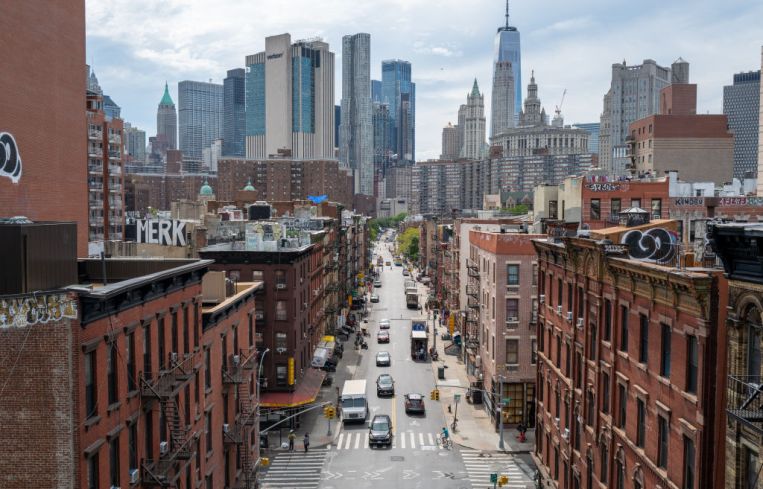New York City Multifamily Is a Port Amid the Stock Market Storm
By Lev Mavashev April 29, 2025 10:27 am
reprints
The stock market doesn’t like surprises, and this month’s “Liberation Day” tariffs sent it into full-blown panic mode. A 10 percent blanket tariff on nearly all imports, with some countries slapped with duties as high as 60 percent, and China facing a staggering 100 percent-plus rate? That’s not exactly market-friendly.
Add to that the Federal Reserve caught between inflation fears and a slowing economy, and it’s no surprise that equities took a beating while uncertainty indexes hit near-record highs.
But here’s the thing: While Wall Street flinches, New York City multifamily real estate remains solid. Let’s break this down.
The recent trade policy shift represents one of the most significant moves in U.S. economic policy in over a century. The immediate fallout? A volatile bond market, a rattled Fed, and rising inflation expectations — now forecast to hit the mid-4 percent range.

But here’s where it gets interesting: Apartment fundamentals remain resilient. While some parts of the commercial property world are wobbling, NYC multifamily has quietly kept its footing.
According to first-quarter 2025 data, apartment vacancy ticked down by 10 basis points. Leasing remained strong in late 2024, with over 400,000 units absorbed nationwide in just six months. Construction activity, already hampered by material costs, will likely slow further due to tariffs on building supplies. But that’s exactly what will keep supply in check — and bolster occupancy and rent growth in high-demand metros like NYC.
Let’s not forget, too, New York rents haven’t dropped like in the rest of the country. Nationwide, oversupply has cooled rents. But not here. Manhattan and Brooklyn rents continue to edge higher. That’s the kind of demand stability investors crave, especially in a market riddled with uncertainty.
While the headlines scream volatility, I think real estate investors should tune out the noise and zero in on what really matters: Debt markets are improving, and that spells opportunity.
Yes, the 10-year Treasury spiked to 4.4 percent in early April, its sharpest three-day climb since 2001. But let’s zoom out. Rates remain historically low, and, more importantly, financing windows are opening. We’ve seen well-timed borrowers lock in favorable terms, even amid the chaos. Those narrow windows to secure debt are exactly what savvy investors should be hunting right now.
Treasury yields are swinging wildly because nobody knows if the Fed will blink or stand firm. That indecision may be paralyzing Wall Street, but, in real estate, it means opportunity for those with conviction and dry powder. Foreign capital is already acting, buying market-rate NYC multifamily buildings for cash, and closing in days. If that doesn’t show conviction, I don’t know what does.
Another overlooked aspect of these tariffs is how they’ll slow construction even further. Steel, aluminum and imported appliances are all under tariff pressure. Developers, already cautious due to financing hurdles and rising costs, will now face even more resistance.
That’s not great for supply, but it’s bullish for owners. With fewer new units coming online, competition among landlords drops, and pricing power increases. This is a key reason institutional investors are flocking back to the NYC multifamily space. Delayed homeownership among millennials, paired with rising costs to build homes, means more renters and less new supply. That’s a recipe for long-term value growth.
Let’s be real: These tariffs are adding uncertainty at a time when we least need it. Consumer sentiment has fallen over 30 percent since December. The Economic Policy Uncertainty Index hit its second-highest reading on record. Equity markets are rattled. Business investment is slowing.
But multifamily isn’t Wall Street. It’s not priced by the second. It’s grounded in leases, long-term demand, and hard assets.
Right now, NYC multifamily offers clarity in an unclear world. Investors are returning to the market because the fundamentals — rent growth, tenant demand, stable cap rates — still make sense.
As an investor, you have to ask yourself: Am I chasing the next high-frequency trade, or am I building something stable?
Tariffs will shake up global trade and rattle financial markets. But they’re also forcing a revaluation of asset classes. And in that recalibration, NYC multifamily stands tall. For those looking to navigate the storm — and position themselves for what comes next — the time to act is now. Leverage is improving, supply is constrained, and demand is durable.
Wall Street may panic. But if history’s any guide, NYC multifamily will do what it’s always done: weather the storm, and come out stronger.
Lev Mavashev is founder and principal of Alpha Realty, a New York brokerage focusing on multifamily.


